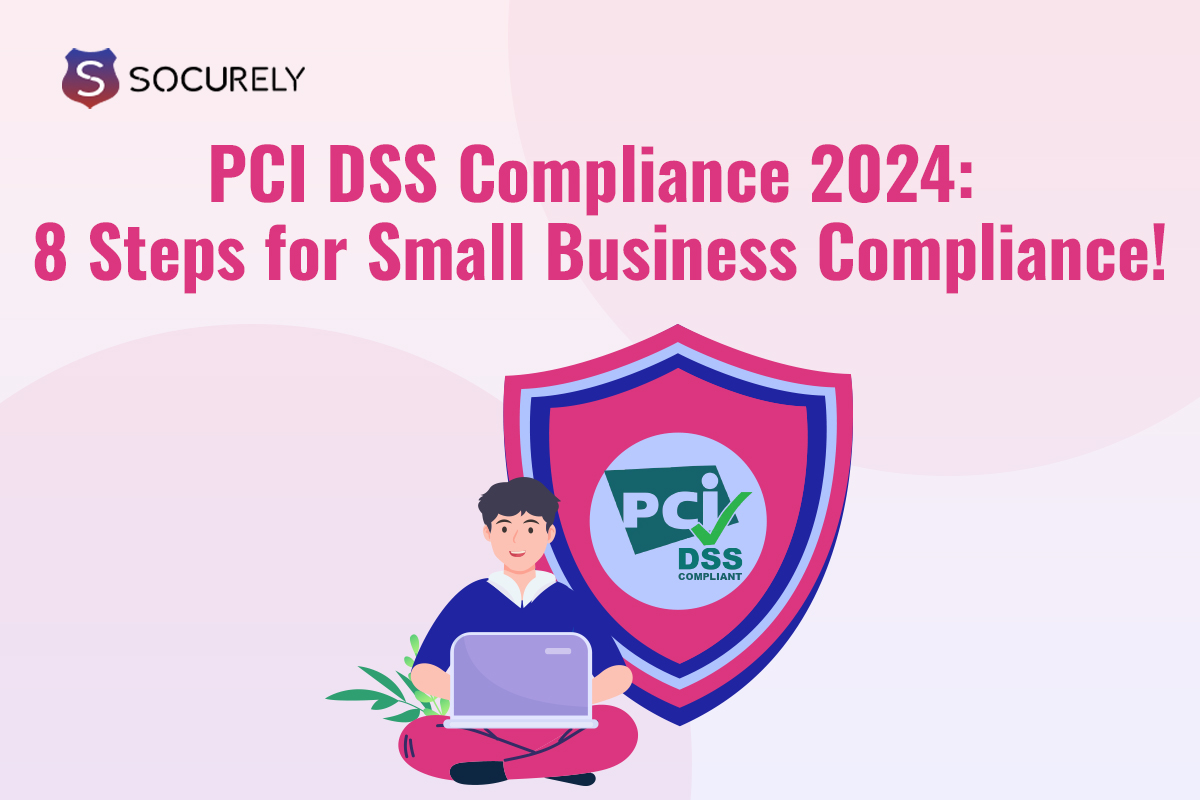Startups and small businesses process fewer transactions but need a secure measure for safety from data breaches and hackers. It means a secure process for all transactions. It is when the PCI DSS Framework comes into play.
On the other hand, large enterprises process over 30,000 transactions per year, which includes a prominent bond.
Security standards such as the Payment Card Industry Data Security Standard (PCI DSS) are designed to ensure that a secure environment is maintained for companies that accept, process, store, or transmit credit card information. It indicates transactions or accepting payments via POS (Point Of Sale) and non-POS channels followed by specific requirements.
However, the readiness and compliance journey of small businesses is different from that of large enterprises.
According to recent statistics, data breaches exposed over 4.1 billion records in the first half of 2019 alone, emphasizing the importance of robust security measures like PCI DSS compliance.
The goal of this small company PCI compliance blog is to provide you with useful information. It provides an overview of the average cost of PCI compliance for small businesses, maps out the PCI DSS compliance path for a small firm, and explains the processes necessary to become PCI DSS compliant.
So without wasting time, let’s get started with small business PCI DSS.
Small Business PCI DSS Compliance
Small or large, we can help! If your business processes an electronic transaction yearly, it is mandatory to comply with PCI DSS.
Startups and small businesses hence need to be compliant with PCI DSS following the PCI Standards to promote secure transactions.
- According to Verizon research from 2019, over 43% of cyberattacks targeted small firms, and just 14% of those organizations were able to successfully ward off the attacks.
For small businesses, achieving PCI DSS compliance can seem daunting. However, it’s essential for safeguarding sensitive payment information and maintaining customer trust. Compliance helps prevent data breaches, which can be devastating for small businesses both financially and reputationally. Understanding the PCI DSS requirements and how they apply to small businesses is the first step toward compliance.
The PCI DSS Requirements For Small Business
The PCI DSS requirements consist of 12 high-level mandates grouped into six goals:
- Build and Maintain a Secure Network
- Set up and keep up a firewall to safeguard cardholder data.
- System passwords and other security parameters should not be set to vendor defaults.
- Protect Cardholder Data
- Protect stored cardholder data.
- Open, public networks should be encrypted when transmitting cardholder data.
- Maintain a Vulnerability Management Program
- Use and regularly update anti-virus software.
- Develop and maintain secure systems and applications.
- Implement Strong Access Control Measures
- Restrict access to cardholder data by business need-to-know.
- Each person with access to a computer should be assigned a unique ID.
- Restrict physical access to cardholder data.
- Regularly Monitor and Test Networks
- Keep track and monitor all access to network resources and cardholder data.
- Regularly test security systems and processes.
- Maintain an Information Security Policy
- Keep an information security policy in place for both contractors and employees.
The Four Compliance Levels Of PCI DSS
PCI DSS compliance is categorized into four levels based on the volume of card transactions a business processes annually:
- Level 1: More than six million transactions annually.
- Level 2: Approximately one million to six million transactions annually.
- Level 3: Twenty thousand to a million transactions annually.
- Level 4: Annually less than 20,000 transactions
Small companies are defined as those that process fewer than 20,000 VISA transactions annually and no more than one million transactions overall.
Level 4 enterprises usually include mom-and-pop shops, boutique design clothing companies, and other businesses. Still, a tiny number of e-commerce-based companies could qualify as Level 3 companies. So it can be said that small businesses typically fall into Levels 3 or 4, requiring different validation and reporting processes.
It’s crucial to understand that, in the event of a security network breach, your company instantly moves up to Level 1, regardless of which Level you are in.
Were you aware?
According to a Hiscox analysis, in the first quarter of 2022, 34% of small enterprises with fewer than 50 workers experienced an attack or security breach. This indicates that the average cost of PCI compliance for their small firm increased. For the impacted small enterprises, the yearly cost of PCI compliance exceeded $300,000. Sadly, the majority of small enterprises were not able to withstand that impact.
Steps To Get PCI DSS Compliance For Small Business
Step 1: Determine Your PCI Compliance Level
To begin, identify which PCI compliance level your business falls into based on the number of Visa transactions processed annually. Small businesses typically fall under Level 4, processing fewer than 20,000 transactions per year. If you’re unsure, use your POS system to generate transaction reports.
Step 2: Fill Out the PCI Self-Assessment Questionnaire (SAQ)
Complete the relevant Self-Assessment Questionnaire (SAQ) based on your transaction methods. For instance:
- If using a payment gateway like Razorpay, fill out SAQ-A.
- For physical stores with a POS system, use SAQ-C.
- For phone orders and online invoices, use SAQ-C-VT.
Access the official PCI DSS website to download the necessary forms. Ensure you understand and answer each question accurately. If needed, seek help from a PCI Qualified Security Assessor (QSA).
Because there are so many Yes/No questions on the self-assessment form, it might occasionally appear complicated. Complete the form without any hesitation and with complete confidence in your testing methods.
Towards the conclusion of the SAQ, there is another part that discusses situations in which your small business has not followed any of the 12 PCI DSS criteria. In this part, you can outline your plan of action for implementing the need, describe the actions you would take, and provide a deadline for finishing the work on time.
Step 3: Examine your payment system
Cyberattacks on cloud-based enterprises increased by 88% in 2021. There is a genuine and present risk of an impending data security breach.
To securely transfer cardholder data, small businesses handling online card transactions should make sure they have a PCI-compliant payment gateway in place.
Adding an SSL (Secure Sockets Layer) will make your website impenetrable to hackers. When making or receiving a card-based payment, instead, employ an encryption code that encrypts all connections between your website and web browser.
The following are some best practices that small companies can begin using:
- Make sure your information systems are safe by implementing access control. Critical data must only be accessible to workers, who have a defined need to access customer information.
- Keep track of every incident of a login in your workplace.
- Set up Point-to-point Encryption (P2PE) and 2FA to make sure that card login details aren’t taken online.
Step 4: Establish and record the procedure for compliance
According to an UpCity survey, more than half of small firms lacked established cybersecurity protection frameworks or procedures to protect themselves from cyber threats, even though more than 80% of them were aware of the dangers and potential consequences of a security event.
To avoid the risk, it is better to document all security controls and policies within your business. Conduct regular employee training on handling customer data securely and perform periodic checks on POS devices to prevent tampering. Educate your team on the financial and security risks associated with poor data management. This implementation further will encourage and strengthen your organization’s overall security posture.
Follow the given things to train your employees in customer data handling-
- Make routine inspections to make sure that your point-of-sale (POS) devices remain unaltered. Give your staff security-related advice for POS equipment.
- Provide staff with regular general awareness training and make sure they understand the financial liabilities and hazards that come with handling information technology poorly for your small business.
Step 5: Complete Your Attestation of Compliance (AoC)
Submit your completed SAQ to the PCI council for review. Ensure all sections are filled out correctly and the form is signed. A QSA will review your SAQ, and if everything is in order, you will receive an AoC, confirming your compliance.
Being a PCI Level 4 company, your AOC will be simple. The AOC is yours to do on your own.
Step 6: Prove Compliance with Vulnerability Scanning
Engage an Approved Scanning Vendor (ASV) to conduct quarterly vulnerability scans of your systems. The ASV will check your firewalls and networks for potential security risks. Submit the scan results to the PCI council as part of your compliance process.
Step 7: Submit PCI Documentation
Gather all relevant documents, including your SAQ, AoC, and vulnerability scan results, and submit them to the PCI council. This documentation proves your compliance and ensures you meet all PCI DSS requirements.
These papers ought to be included in the report:
- An overview of the results
- Audit Information
- Infrastructure for Business Information Card Payment
- external connections
Step 8: Track and Test Your Systems
PCI DSS compliance is an ongoing process. Continuously monitor and test your systems to maintain a strong security posture. Regularly update your documentation and ensure all security measures remain effective to protect customer data.
By following these eight steps, your small business can achieve and maintain PCI DSS compliance, ensuring the security of your customer’s payment information and safeguarding your business from potential data breaches. Also, Without investing too much effort, you may use this cheat sheet to make sure that every item in your business settings is routinely evaluated.
The Importance Of PCI DSS Revealed
PCI DSS compliance offers numerous benefits for small businesses. It helps prevent data breaches, which can result in costly fines and damage to your business’s reputation. Compliance also demonstrates to customers that you take data security seriously, building trust and potentially increasing customer loyalty. Moreover, maintaining PCI DSS compliance can streamline your business operations by ensuring you have robust security measures in place.
How Socurely Helps Your Small Business?
Socurely provides comprehensive support for small businesses aiming for PCI DSS compliance. Their services include:
- Running SOC 2 Compliance Scans: Socurely conducts thorough compliance scans to identify any potential security gaps and vulnerabilities.
- Performing a Manual Compliance Gap Analysis: Their experts perform a detailed analysis to pinpoint areas that need improvement.
- Guidance and Support: From initial assessment to final certification, Socurely offers step-by-step guidance to ensure your business meets all PCI DSS requirements.
- Training and Documentation: Socurely provides training for your staff and helps you maintain all necessary compliance documentation.
- Ongoing Monitoring: They offer continuous monitoring services to help you maintain compliance over time.
Conclusion
Achieving PCI DSS compliance is a critical step for small businesses to protect customer data, build trust, and avoid costly data breaches. By following the outlined steps and leveraging expert support from companies like Socurely, small businesses can effectively secure PCI DSS compliance and enhance their overall security posture.
FAQ
Why is PCI DSS compliance important for small businesses?
PCI DSS compliance helps small businesses protect sensitive payment information, prevent data breaches, and build customer trust.
What are the four levels of PCI DSS compliance?
The four levels of PCI DSS compliance are based on the volume of card transactions processed annually: Level 1 (over 6 million), Level 2 (1-6 million), Level 3 (20,000-1 million), and Level 4 (fewer than 20,000).
How can small businesses achieve PCI DSS compliance?
Small businesses can achieve PCI DSS compliance by determining their PCI level, completing a Self-Assessment Questionnaire (SAQ), conducting vulnerability scans, implementing necessary security controls, and maintaining documentation and monitoring.
How does Socurely help with PCI DSS compliance?
Socurely provides services such as compliance scans, manual gap analysis, training, documentation support, and ongoing monitoring to help small businesses achieve and maintain PCI DSS compliance.







